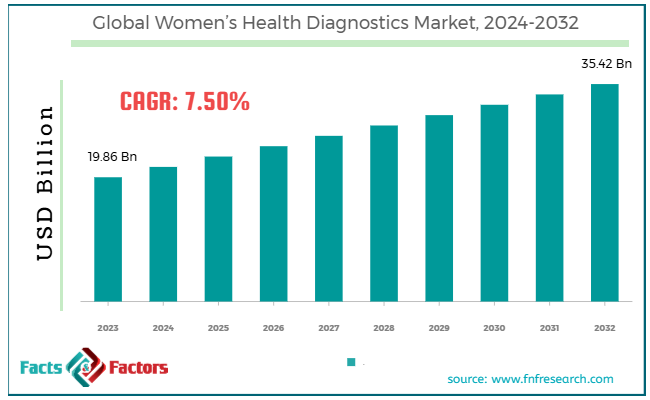Search Market Research Report
Women’s Health Diagnostics Market Size, Share Global Analysis Report, 2024 – 2032

Women’s Health Diagnostics Market Size, Share, Growth Analysis Report By Applications (Prenatal, Pregnancy & Fertility, Osteoporosis, Infectious Diseases, Cancer, And Others), By End-Users (Home Care, Laboratories, Hospitals, And Others), By Types (Accessories & Consumables, Diagnostic Tests, Diagnostic Devices, And Others), And By Region - Global Industry Insights, Overview, Comprehensive Analysis, Trends, Statistical Research, Market Intelligence, Historical Data and Forecast 2024 – 2032
Industry Insights
[221+ Pages Report] According to Facts & Factors the global women’s health diagnostics market size was valued at USD 19.86 billion in 2023 and is predicted to surpass USD 35.42 billion by the end of 2032. The women’s health diagnostics industry is expected to grow by a CAGR of 7.50% between 2024 and 2032.

 Women’s Health Diagnostics Market: Overview
Women’s Health Diagnostics Market: Overview
Women’s health diagnostics includes diverse medical tests and procedures for managing women’s overall health. These diagnostic tests help women prevent and manage many life-threatening diseases. Nowadays, women are actively involved in regularly maintaining their reproductive and cardiovascular health. Moreover, they are becoming more aware of early diagnosis, like cancer screening, to facilitate timely intervention and management of their prevailing health conditions.
 Key Insights
Key Insights
- As per the analysis shared by our research analyst, the global women’s health diagnostics market size is estimated to grow annually at a CAGR of around 7.50% over the forecast period (2024-2032).
- In terms of revenue, the global women’s health diagnostics market size was valued at around USD 19.86 billion in 2023 and is projected to reach USD 35.42 billion by 2032.
- Rising prevalence of lifestyle-induced diseases is driving the growth of the global women’s health diagnostics market.
- Based on the applications, the cancer segment is growing at a high rate and is projected to dominate the global market.
- Based on end-users, the hospital segment is anticipated to grow with the highest CAGR in the global market.
- Based on the types, the diagnostic devices segment is projected to swipe the largest market share.
- Based on region, North America is expected to dominate the global market during the forecast period.
 Women’s Health Diagnostics Market: Growth Drivers
Women’s Health Diagnostics Market: Growth Drivers
- Rising prevalence of lifestyle-induced diseases is driving the growth of the global market.
There is an increasing incidence of lifestyle-associated health conditions like diabetes, heart disease, and many others, particularly among women, which is a major factor driving the growth of the global women’s health diagnostics market.
Also, the epidemiological shift from infectious diseases to chronic diseases like osteoporosis and cancer in women is further fostering a high demand for advanced diagnostic tools in the market.
Government initiatives and awareness programs are also playing a vital role in boosting the growth of the market. Many non-government organizations are also launching educational campaigns to promote women’s health.
The emergence of point-of-care testing is another crucial reason for the high demand for portable diagnostic devices, which in turn will also boost the sales revenue of the industry in the coming years. Such point-of-care devices facilitate better efficiency and accessibility in disease diagnosis. All these factors are likely to collectively accentuate the growth of the market during the forecast period.
For instance, F. Hoffmann-La Roche Ltd. came up with uPath HER2 (4B5) Image Analysis in 2021. The company is aimed to expand its offering in the women's health diagnostics market.
 Women’s Health Diagnostics Market: Restraints
Women’s Health Diagnostics Market: Restraints
- High cost of diagnostic solutions is likely to hamper the growth of the global market.
Advanced diagnostic tests are quite expensive, which restricts many women from receiving their benefits. Also, the limited accessibility of these diagnostic tests is further anticipated to slow down the growth of the women’s health diagnostics industry. Limited awareness among women regarding possible health issues is also likely to negatively impact the growth of the industry.
 Women’s Health Diagnostics Market: Opportunities
Women’s Health Diagnostics Market: Opportunities
- Expansion of diagnostics and imaging centers is expected to foster growth opportunities in the global market.
Many diagnostic and imaging centers are expanding their networks rapidly to a wider audience to help women get regular health screenings and checkups. Organizations are investing heavily in making such healthcare services more accessible.
However, the rapidly increasing female aging population is another major factor positively influencing the demand for diagnostic services in the global women’s health diagnostics market.
Additionally, technological advancements in diagnostic equipment are likely to open numerous growth opportunities in the industry in the coming years.
For instance, Determine HIV-1/2 Ag/Ab by Alere company was approved by the FDA in 2018 to identify HIV p24 antibodies and antigens via POC testing.
 Women’s Health Diagnostics Market: Challenges
Women’s Health Diagnostics Market: Challenges
- Cultural barriers are a big challenge in the global market.
There is a big social stigma and cultural taboo in society which restricts women from obtaining regular healthcare screenings. Such a landscape limits the scope of the women’s health diagnostics industry and leads to the underutilization of diagnostic services. Gender bias is another major factor likely to negatively impact the growth of the industry.
 Report Scope
Report Scope
Report Attribute |
Details |
Market Size in 2023 |
USD 19.86 Billion |
Projected Market Size in 2032 |
USD 35.42 Billion |
CAGR Growth Rate |
7.5% CAGR |
Base Year |
2023 |
Forecast Years |
2024-2032 |
Key Market Players |
Cardinal Health Inc., Thermo Fisher Scientific Inc., Aspire Women's Health, Koninklijke Philips N.V., Ge Healthcare, Abbott, F. Hoffmann-La Roche Ltd., and others. |
Key Segment |
By Applications, By End-Users, By Types, and Region |
Major Regions Covered |
North America, Europe, Asia Pacific, Latin America, and the Middle East &, Africa |
Purchase Options |
Request customized purchase options to meet your research needs. Explore purchase options |
 Women’s Health Diagnostics Market: Segmentation
Women’s Health Diagnostics Market: Segmentation
The global women’s health diagnostics market can be segmented into applications, end-users, types, and others.
On the basis of applications, the market can be segmented into prenatal, pregnancy & fertility, osteoporosis, infectious diseases, cancer, and others. Cancer is the fastest-growing segment in the women’s health diagnostics industry during the forecast period.
The rising prevalence of cancer globally is one of the leading reasons for the high growth rate of the segment. Moreover, the growing incidences of cancers, particularly in women like cervical cancer, ovarian cancer, breast cancer, and endometrial cancer, are further widening the scope of the segment.
In recent years, the healthcare system has witnessed the highest number of breast cancer diagnoses. Also, the rapid advancements in diagnostic technologies are paving the way for a high growth rate in the segment. Developments like next-generation sequencing, molecular diagnostics, and liquid biopsy are further fostering more accurate diagnosis.
Additionally, the emergence of personalized medicine is also expected to positively influence the growth of the segment. Genetic testing and precision medicine facilitate early detection and targeted therapy, which is highly useful in the treatment of cancer and promotes the growth of the segment in the market.
However, the rising awareness among people, along with the preventive screening and educational programs by the government regarding self-breast examination and genetic testing, is also anticipated to foster many growth opportunities in the segment in the coming years.
On the basis of end-users, the market can be segmented into home care, laboratories, hospitals, and others. The hospital segment will account for the largest share of the global women’s health diagnostics market during the forecast period. One of the major factors driving the growth of the segment is the high patient volume in hospital centers.
Also, hospitals are capable of offering comprehensive diagnostic services for diverse diseases and healthcare conditions, which is another major factor influencing the growth of the segment. Additionally, these centers have specialized machinery, screening equipment, and specialized healthcare professionals to treat patients, which further attracts people.
The dominance of the segment is also because of the integration of hospital services with many other care communities that can provide follow-up care to patients. Government policies and leading campaigns offer free healthcare programs and reimbursement policies, which further encourage people to adopt hospital services.
On the basis of type, the market can be segmented into accessories & consumables, diagnostic tests, diagnostic devices, and others. The diagnostic devices segment is likely to dominate the women’s health diagnostics industry during the forecast period. The rising incidences of chronic diseases are one of the major factors promoting the growth of the segment. People are well educated and informed regarding the importance of early detection and disease management, which further encourages people to get advanced diagnoses.
Moreover, the rising trend of point-of-care testing is anticipated to facilitate a higher growth rate in the segment. These help patients get the advantages of portable diagnostic devices, which offer fast results and better outcomes.
Also, the increasing number of healthcare facilities, particularly specific to diagnostic centers, is likely to support the growth of this segment. Many underdeveloped and developing economies are comprehensive, including diagnostic centers in their expansion plans, which is also likely to strengthen the demand for diagnostic equipment in the market in the coming years.
 Women’s Health Diagnostics Market: Regional Analysis
Women’s Health Diagnostics Market: Regional Analysis
- North America to dominate the global market.
North America is likely to account for the largest share of the global women’s health diagnostics market during the forecast period. The region is witnessing increasing incidences of chronic diseases, which is a major reason driving the growth of the market. The growing awareness among people regarding early detection and regular screening is fostering a high demand for diagnostic tools in the regional market. North America has a high prevalence of breast and ovarian cancer, which is also a crucial reason for the high growth of industry in the region.
The North American government is making numerous efforts to educate people through awareness campaigns regarding women’s health. The region is at the forefront of technological advancements, which are further contributing immensely to the growth of the North American market.
The United States is leading the market growth because of the high healthcare spending and increasing awareness among women regarding early detection and preventive care measures. Canada is another major region likely to dominate the growth of the North American market because of the presence of advanced diagnostic technologies and the fast-expanding healthcare sector.
Asia-Pacific is also expected to witness significant developments in the coming years. China is projected to lead the market because of the rapid technological advancements. Also, the country is coming up with new diagnostic test kits, which are likely to facilitate the early detection and management of several diseases specifically for women’s health.
Additionally, the growing awareness in APAC regarding the importance of women’s health and well-being is likely to positively impact the growth trajectory of the market further. India is also likely to see huge developments in the coming years because of the rising attention of international device manufacturers towards the region. These companies are realizing the scope of the market in the Indian subcontinent, thereby expanding their distribution network with advanced diagnostic tools in the region.
For instance, Carestream Health Inc. came up with a new operational unit in Mumbai in 2019 to extend its functioning in the market.
 Women’s Health Diagnostics Market: Competitive Analysis
Women’s Health Diagnostics Market: Competitive Analysis
The key players in the global women’s health diagnostics market include..
- Cardinal Health Inc.
- Thermo Fisher Scientific Inc.
- Aspire Women's Health
- Koninklijke Philips N.V.
- Ge Healthcare
- Abbott
- F. Hoffmann-La Roche Ltd.
For instance, Hologic Inc. took over Biotheranostics in 2021 to offer molecular diagnostics tests for metastatic cancers. These initiatives are expected to strengthen the company's reputation in the women's health diagnostics market.
The global women’s health diagnostics market is segmented as follows:
 By Applications
By Applications
- Prenatal
- Pregnancy & Fertility
- Osteoporosis
- Infectious Diseases
- Cancer
- Others
 By End-Users
By End-Users
- Home Care
- Laboratories
- Hospitals
- Others
 By Types
By Types
- Accessories & Consumables
- Diagnostic Tests
- Diagnostic Devices
- Others
 By Regional Segment Analysis
By Regional Segment Analysis
- North America
- The U.S.
- Canada
- Mexico
- Europe
- France
- The UK
- Spain
- Germany
- Italy
- Rest of Europe
- Asia Pacific
- China
- Japan
- India
- Australia
- Southeast Asia
- Rest of Asia Pacific
- The Middle East & Africa
- Saudi Arabia
- UAE
- Egypt
- Kuwait
- South Africa
- Rest of the Middle East & Africa
- Latin America
- Brazil
- Argentina
- Rest of Latin America
Industry Major Market Players
- Cardinal Health Inc.
- Thermo Fisher Scientific Inc.
- Aspire Women's Health
- Koninklijke Philips N.V.
- Ge Healthcare
- Abbott
- F. Hoffmann-La Roche Ltd.
Frequently Asked Questions
Which key factors will influence the global women’s health diagnostics market growth over 2024-2032?

Copyright © 2024 - 2025, All Rights Reserved, Facts and Factors


